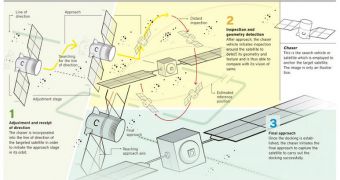A group of Spanish researchers has recently announced the creation of a new type of automated satellite docking and capture system, which allows robots to autonomously trap target spacecrafts.
The new system relies on the use of enhanced computer vision technologies to help it navigate its way until it reaches its targets. The project was developed at the Universidad Carlos III de Madrid (UC3M).
The initiative is called “Docking and Capture of Satellites through computer vision,” or ASIROV for short, Space Fellowship reports.
Within this framework, the research group has produced new and advanced mathematical algorithms that allows for a salvage spacecraft to home in and capture disabled or malfunctioning satellites.
“In this way, we attempt to carry out all the phases of a satellite inspection and maintenance mission with another autonomous vehicle equipped with a robotic system for capture and control,” says expert Mohamed Abderrahim.
The researcher is based at the UC3M Department of Automated Systems Engineering, and he is also the leader of the new investigation. He adds that the recovery spacecraft is called a “chaser.”
The university itself is not directly involved with the manufacture or launching of the rescue satellites, experts say. Their involvement deals exclusively with developing the intricate algorithms needed.
What the new mathematical formulas can do is scan the crowded orbits that satellites use in search for a very specific target, and then calculate its own path on how to get there with the least amount of effort.
Vision techniques are the basis for this approach, and the UC3M team is really produces of what it managed to accomplish here. Their system can not only salvage or deorbit satellites, but also prolong their initial life span.
“Today there is a growing need to provide satellite maintenance services, without relying on manned missions, which are very costly and involve risks. Robotics is the natural solution,” Abderrahim adds.
The new vision technologies that will go on the spacecraft are “quite robust against noise, changes in the background and variations in illumination,” the expert goes on to say.
An added advantage of the system is that “the speed of the algorithm allows it to be used in real time,” he adds. This means that human operators may step in at any time to correct potential errors.
In the near future, systems such as this one may make it cheaper to keep satellites in orbit, as old spacecrafts will be repaired, and their life span extended.
This will in turn eliminate the need to launch new satellites very often.

 14 DAY TRIAL //
14 DAY TRIAL //